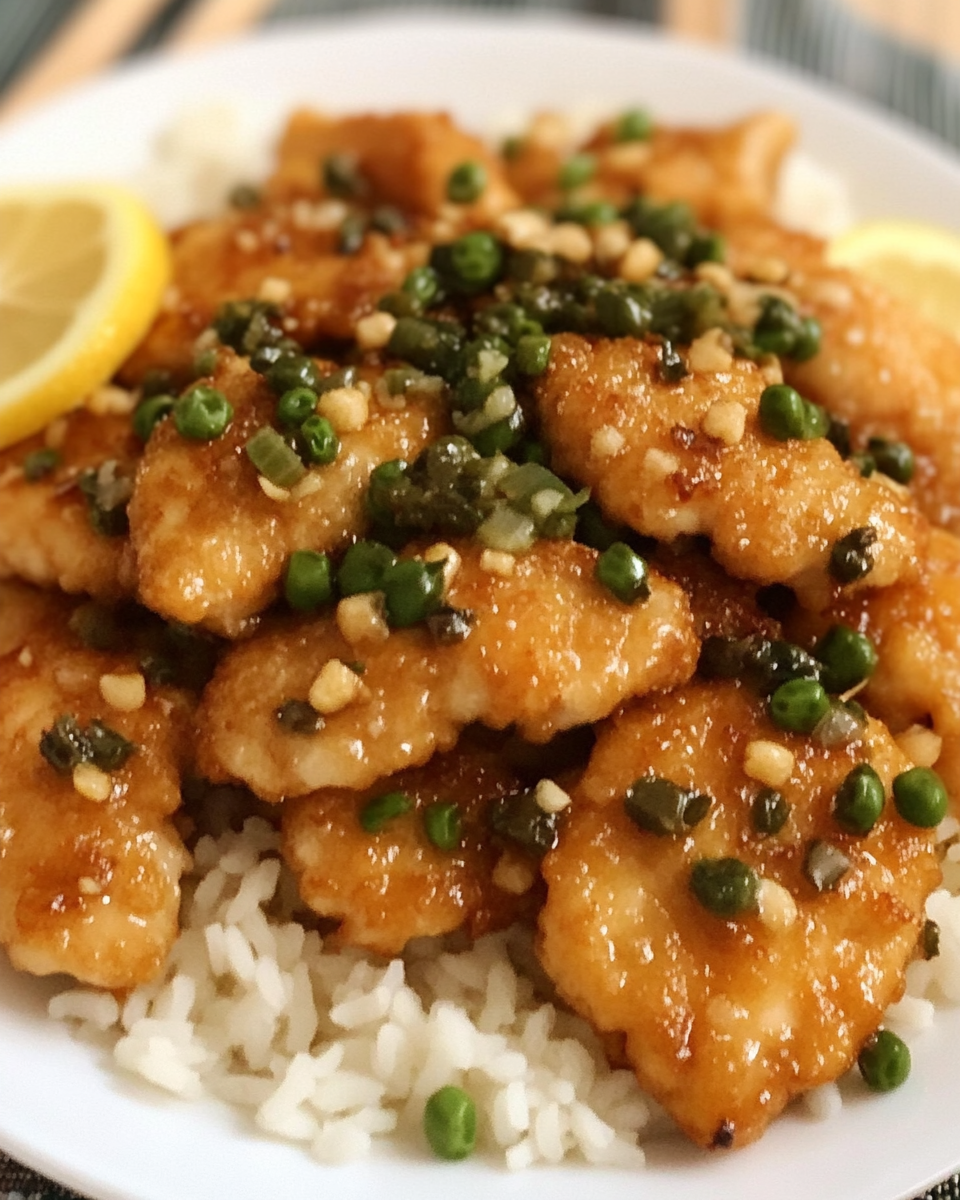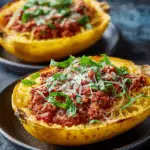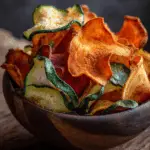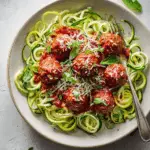A zesty and elegant Italian-American dish, Chicken Piccata features tender chicken breasts pan-seared to golden perfection and topped with a tangy lemon-butter caper sauce. This quick and flavorful meal is perfect for weeknights or special occasions.
FULL RECIPE
Ingredients
- 2 boneless, skinless chicken breasts (halved horizontally)
- 1/2 cup all-purpose flour (for dredging)
- 1/2 teaspoon salt
- 1/4 teaspoon black pepper
- 2 tablespoons olive oil
- 2 tablespoons unsalted butter
- 1/3 cup dry white wine or chicken broth
- 1/4 cup fresh lemon juice
- 1/4 cup capers (drained and rinsed)
- 1/3 cup chicken broth
- 2 tablespoons fresh parsley (chopped)
- Lemon slices (for garnish, optional)
Directions
- Flatten each chicken cutlet to about 1/2-inch thickness using a meat mallet.
- In a shallow dish, mix flour with salt and pepper. Dredge chicken in the flour mixture, shaking off excess.
- Heat olive oil and 1 tablespoon butter in a large skillet over medium heat.
- Add chicken to the pan and cook for 3–4 minutes per side until golden and cooked through. Remove and set aside.
- In the same skillet, add wine (or broth), lemon juice, capers, and remaining broth. Bring to a simmer, scraping any browned bits from the pan.
- Reduce the sauce for 3–4 minutes, then stir in the remaining tablespoon of butter.
- Return chicken to the pan and simmer for 2 more minutes to heat through and coat with sauce.
- Sprinkle with parsley and garnish with lemon slices if desired. Serve immediately.
Nutritional Information
- Calories: 320
- Protein: 28g
- Carbohydrates: 10g
- Fat: 18g
- Saturated Fat: 6g
- Sodium: 540mg
- Fiber: 1g
- Sugar: 1g
History of Chicken Piccata
Chicken Piccata has its roots in Italian cuisine, particularly from the regions of Northern Italy where piccata is a cooking method traditionally used with veal. The word “piccata” means “pierced” or “stabbed,” referring to the preparation style of slicing the meat thinly. Over time, the recipe evolved, and chicken became a popular substitute for veal due to its accessibility and milder flavor. This adaptation became especially widespread in Italian-American households, where Chicken Piccata is now a beloved classic.
Flavor Profile
The dish balances bright, tangy lemon with the salty, briny taste of capers, creating a lively contrast to the savory, tender chicken. The butter adds richness, while the white wine or broth adds depth and complexity. This combination makes Chicken Piccata flavorful but light, ideal for those seeking a fresh yet comforting meal.
Variations of Chicken Piccata
Though the classic recipe stays fairly consistent, variations exist depending on the region or personal preferences. Some versions incorporate garlic or shallots for an aromatic punch, while others add fresh herbs like thyme or rosemary. Substituting chicken with other proteins like turkey, fish, or tofu is also common for dietary adjustments.
Why Use Capers?
Capers are the star ingredient that gives Chicken Piccata its distinctive zing. These small flower buds, pickled in brine or vinegar, provide a sharp, salty flavor that complements the lemon and butter sauce perfectly. Their unique taste enhances the overall complexity of the dish without overpowering it.
Lemon’s Role in the Dish
Lemon juice is essential in Chicken Piccata, contributing brightness and acidity that cuts through the richness of butter and olive oil. Fresh lemon juice is preferred over bottled varieties because it offers a cleaner, fresher flavor. The citrus also helps tenderize the chicken slightly, making each bite juicy.
Choosing the Right Chicken
For the best results, boneless, skinless chicken breasts are most commonly used. Flattening the chicken breasts ensures even cooking and tenderness. Using fresh, high-quality chicken will impact the final texture and flavor positively.
Cooking Techniques for Perfect Chicken Piccata
Pan-searing the chicken in olive oil and butter creates a golden crust while sealing in juices. The flour dredge helps achieve this crust and also thickens the sauce slightly. Deglazing the pan with wine or broth lifts the flavorful browned bits, enriching the sauce and enhancing the overall taste.
How to Make the Sauce
The sauce is a delicate balance of lemon juice, capers, broth, and butter. Simmering these ingredients together allows the flavors to meld, while finishing with butter adds a smooth, velvety texture. The sauce should be tangy but balanced, not overly sour or salty.
Wine Pairings for Chicken Piccata
Light, crisp white wines like Pinot Grigio, Sauvignon Blanc, or a dry Chardonnay pair beautifully with Chicken Piccata. Their acidity matches the lemon in the dish, while their subtle fruitiness complements the buttery sauce. Avoid heavy reds that could overpower the delicate flavors.
Side Dishes to Serve with Chicken Piccata
Traditional side dishes include simple pasta tossed in olive oil or butter, roasted or steamed vegetables, or a light green salad. Mashed potatoes or risotto can also work well, as they soak up the flavorful sauce nicely, creating a satisfying meal.
Nutritional Benefits
Chicken Piccata provides a good source of lean protein from the chicken, while the lemon juice adds vitamin C. Although the sauce contains butter and olive oil, the overall dish can be balanced and healthy when paired with fresh vegetables and moderate portions.
Common Mistakes to Avoid
Overcooking the chicken can make it dry and tough. It’s important to cook until just done, as the sauce finishing step will warm the meat further. Using too much flour can create a gummy texture instead of a light crust, so shaking off excess is crucial. Also, adding too much lemon or capers can overpower the dish.
Gluten-Free Adaptations
For gluten-free diets, substitute the all-purpose flour with cornstarch, rice flour, or a gluten-free flour blend for dredging. This adjustment keeps the chicken crispy and maintains the texture of the sauce without compromising flavor.
Vegan and Vegetarian Versions
Though traditionally made with chicken, vegan versions replace the meat with firm tofu, seitan, or eggplant slices. Using vegetable broth and vegan butter substitutes keeps the sauce flavorful and true to the original concept.
Cultural Impact
Chicken Piccata has become a staple in Italian-American cuisine and is often featured in home cooking and restaurant menus across the United States. It represents the adaptation of traditional Italian techniques to local ingredients and preferences.
Presentation Tips
Serving Chicken Piccata on a warm plate with a drizzle of sauce and a sprinkle of fresh parsley elevates its visual appeal. Adding lemon slices as garnish emphasizes the citrus element and makes the dish look vibrant and inviting.
Storage and Leftovers
Chicken Piccata is best enjoyed fresh but can be refrigerated for up to three days. When reheating, do so gently on low heat to avoid drying out the chicken or breaking the sauce. Freezing is possible but may alter the texture of the sauce.
Pairing with Bread
Crusty bread or garlic bread pairs well with Chicken Piccata, providing a perfect vehicle to soak up the luscious sauce. It’s an easy addition that enhances the dining experience and adds comfort to the meal.
Cooking for Special Diets
Chicken Piccata can fit well into low-carb or keto diets by skipping flour or using low-carb alternatives. It is naturally gluten-free when modified and can be adapted for dairy-free needs by substituting butter with oils or dairy-free margarine.
Seasonal Adaptations
In warmer months, serving Chicken Piccata with fresh summer vegetables or a light salad highlights seasonal produce. In colder months, pairing it with roasted root vegetables or creamy polenta adds a comforting, hearty touch.
Conclusion
Chicken Piccata is a versatile and timeless dish that combines simple ingredients to create a complex and satisfying flavor profile. Its balance of tangy lemon, salty capers, and rich butter sauce makes it a crowd-pleaser that fits many occasions, from casual dinners to special celebrations. With room for creativity through variations and adaptations, Chicken Piccata remains a beloved recipe that celebrates both tradition and innovation in the kitchen.






